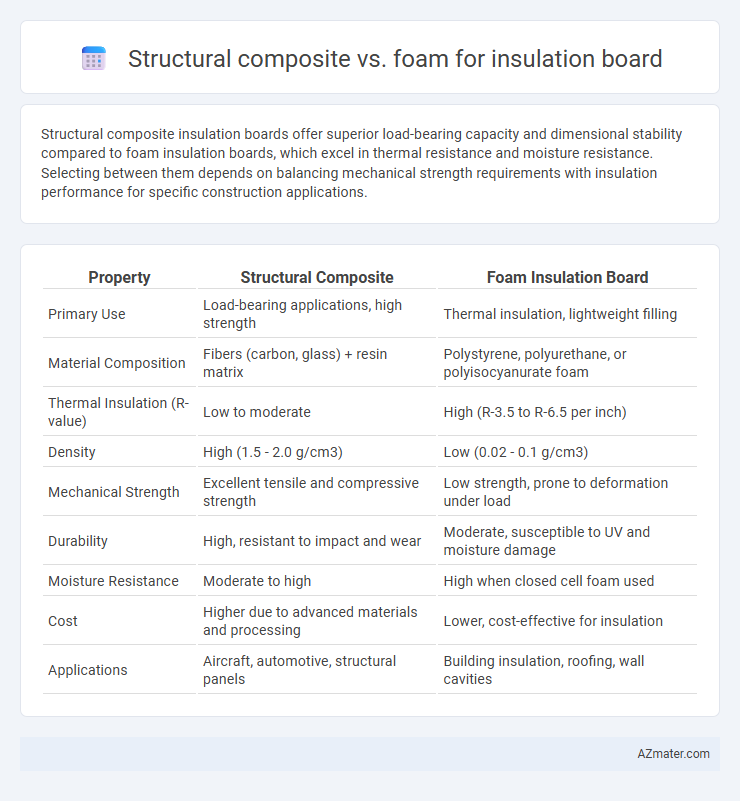Structural composite insulation boards offer superior load-bearing capacity and dimensional stability compared to foam insulation boards, which excel in thermal resistance and moisture resistance. Selecting between them depends on balancing mechanical strength requirements with insulation performance for specific construction applications.
Table of Comparison
| Property | Structural Composite | Foam Insulation Board |
|---|---|---|
| Primary Use | Load-bearing applications, high strength | Thermal insulation, lightweight filling |
| Material Composition | Fibers (carbon, glass) + resin matrix | Polystyrene, polyurethane, or polyisocyanurate foam |
| Thermal Insulation (R-value) | Low to moderate | High (R-3.5 to R-6.5 per inch) |
| Density | High (1.5 - 2.0 g/cm3) | Low (0.02 - 0.1 g/cm3) |
| Mechanical Strength | Excellent tensile and compressive strength | Low strength, prone to deformation under load |
| Durability | High, resistant to impact and wear | Moderate, susceptible to UV and moisture damage |
| Moisture Resistance | Moderate to high | High when closed cell foam used |
| Cost | Higher due to advanced materials and processing | Lower, cost-effective for insulation |
| Applications | Aircraft, automotive, structural panels | Building insulation, roofing, wall cavities |
Introduction: Understanding Insulation Board Materials
Structural composite insulation boards combine high-density materials like wood fibers and resins to provide rigidity and thermal resistance, making them ideal for load-bearing applications. Foam insulation boards, typically made from polystyrene, polyurethane, or polyisocyanurate, offer superior thermal insulation with low density and moisture resistance. Selecting between these materials depends on balancing structural requirements and insulation performance for specific construction needs.
What Are Structural Composites?
Structural composites are engineered materials composed of two or more distinct constituents combined to enhance mechanical strength, durability, and thermal performance, making them ideal for insulation boards in construction. Unlike foam insulation boards, which primarily provide thermal resistance, structural composites integrate fibers or fabrics within a matrix to improve load-bearing capabilities and resistance to environmental stresses. These composites offer superior structural integrity while maintaining effective insulation, making them suitable for applications requiring both strength and thermal efficiency.
Foam Insulation Boards: Composition and Types
Foam insulation boards primarily consist of rigid panels made from materials such as expanded polystyrene (EPS), extruded polystyrene (XPS), and polyisocyanurate (PIR), each offering distinct thermal resistance and moisture resistance properties. EPS provides cost-effective insulation with moderate R-values, while XPS offers higher compressive strength and better water resistance, making it suitable for below-grade applications. Polyisocyanurate boards deliver superior insulation with the highest R-values per inch, often featuring foil facings that enhance their radiant heat barrier capabilities.
Thermal Performance Comparison
Structural composite insulation boards typically offer higher thermal resistance (R-value) ranging from 4 to 6 per inch, making them more effective at reducing heat transfer compared to foam insulation boards, which generally have R-values around 3 to 4 per inch. The denser composition of structural composites provides improved thermal bridging resistance, thereby enhancing overall energy efficiency in buildings. Foam insulation, such as expanded polystyrene (EPS) or polyisocyanurate (PIR), tends to possess better moisture resistance but may underperform structurally and in long-term thermal stability compared to engineered structural composites.
Moisture Resistance: Structural Composite vs Foam
Structural composite insulation boards exhibit superior moisture resistance due to their dense fiber matrix and resin binding, which minimize water absorption and prevent mold growth. Foam insulation boards, such as extruded polystyrene (XPS) and closed-cell spray foam, provide excellent moisture resistance through their low permeability and water-repellent properties. However, structural composites typically offer better long-term dimensional stability in humid environments compared to foam boards, which can degrade or lose insulating effectiveness if exposed to prolonged moisture.
Mechanical Strength and Durability
Structural composite insulation boards exhibit superior mechanical strength and durability compared to foam boards due to their multi-layered construction combining materials like fiberglass, wood fibers, and resins. Foam insulation boards, such as expanded polystyrene (EPS) or extruded polystyrene (XPS), offer lower compressive strength and can degrade under prolonged UV exposure or physical stress. The enhanced load-bearing capacity and resistance to moisture and impact make structural composite boards more suitable for applications requiring long-term structural integrity.
Fire Resistance and Safety Considerations
Structural composite insulation boards exhibit superior fire resistance due to their dense, non-combustible materials that limit flame spread and smoke emission. Foam insulation boards, while offering excellent thermal performance, are generally more flammable and may release toxic fumes when exposed to high heat. Fire safety regulations often prefer structural composites in critical applications such as commercial buildings where enhanced fire retardancy and occupant safety are paramount.
Installation Processes and Practicality
Structural composite insulation boards offer straightforward installation with rigid panels that maintain shape and provide consistent thermal resistance, reducing gaps and air leaks. Foam insulation boards, such as expanded or extruded polystyrene, are lightweight and easier to cut and fit into irregular spaces but may require additional fasteners or adhesives for secure placement. The practicality of structural composites lies in their durability and load-bearing capacity, while foam boards excel in flexibility and ease of handling during installation.
Environmental Impact and Sustainability
Structural composite insulation boards typically use recycled wood fibers combined with adhesives, offering a renewable and biodegradable option that reduces landfill waste. Foam insulation boards, such as those made from polyurethane or polystyrene, rely on petroleum-based materials and may emit greenhouse gases during production and disposal. Choosing structural composites can enhance sustainability by lowering carbon footprints and improving recyclability compared to conventional foam insulation products.
Cost Analysis: Structural Composite vs Foam
Structural composite insulation boards generally have a higher upfront cost compared to foam insulation due to the complexity of materials like fiberglass or mineral wool combined with resins. Foam insulation boards, such as expanded polystyrene (EPS) or extruded polystyrene (XPS), offer a more cost-effective solution with lower material and installation expenses. Long-term savings may vary as structural composites provide enhanced durability and thermal performance, potentially reducing replacement and energy costs over time.

Infographic: Structural composite vs Foam for Insulation board
 azmater.com
azmater.com